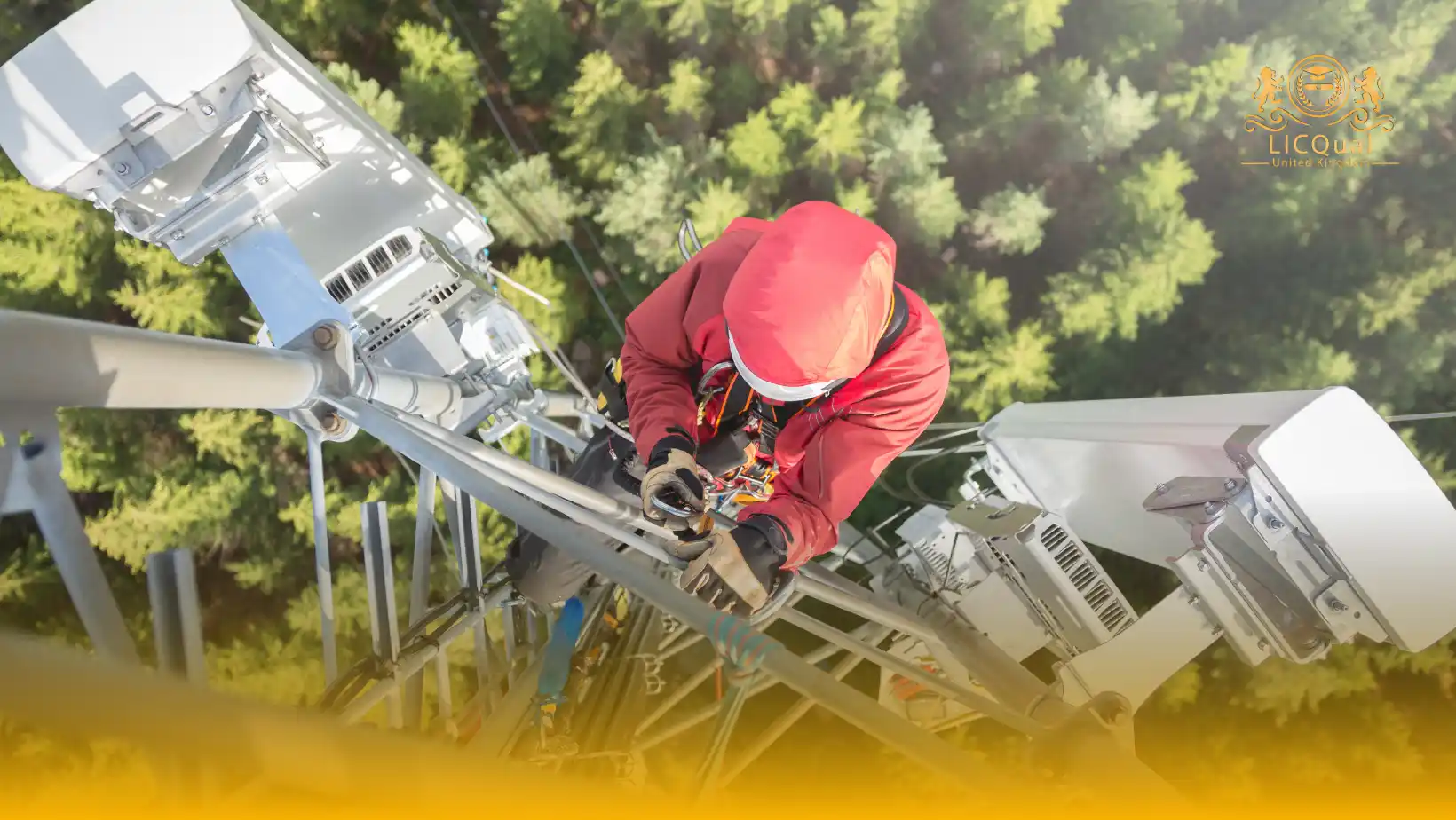The LICQual Level 3 Award in Working at Height is an advanced qualification designed for supervisors, team leaders, and experienced professionals responsible for managing height-related activities in the workplace. This course goes beyond basic awareness, offering strategic and technical competencies required to plan, lead, and evaluate safe working practices at height. With workplace incidents involving falls from height continuing to be a leading cause of serious injuries, this qualification plays a vital role in improving safety performance and compliance.
Focused on real-world application, the LICQual Level 3 Award in Working at Height covers critical topics such as legal compliance, advanced risk assessments, emergency planning, and incident investigation. Learners gain a deep understanding of how to develop and implement control measures, supervise teams working at height, and foster a strong safety culture. The qualification is mapped to international best practices and aligns with occupational health and safety standards, making it ideal for organizations committed to minimizing risk and legal exposure.
Throughout the course, participants engage in dynamic learning activities, including case studies, scenario-based exercises, and group discussions. The LICQual Level 3 Award in Working at Height equips learners with practical tools to lead safety initiatives, evaluate equipment and procedures, and respond to complex challenges in diverse environments. Whether supervising scaffolding work, managing MEWPs, or coordinating rooftop maintenance, learners will be prepared to take informed, proactive actions.
Designed for professionals with previous training or experience in working at height, this course builds upon foundational knowledge and introduces advanced competencies in leadership, incident response, and compliance auditing. The LICQual Level 3 Award in Working at Height is ideal for safety officers, site supervisors, project managers, and others involved in planning and overseeing high-risk tasks. It enhances decision-making and accountability, ensuring safety becomes an integral part of day-to-day operations.
By completing the LICQual Level 3 Award in Working at Height, learners not only demonstrate their ability to manage complex height-related work but also strengthen their professional profile. Employers benefit from reduced risk exposure, improved compliance, and a workforce that prioritizes safety at all levels. This qualification is a key investment in building a safer, more responsible working environment across industries where working at height is a routine yet critical activity.
Course Overview
Qualification Title
LICQual Level 3 Award in Working at Height
Total Units
6
Total Credits
6
GLH
18
Qualification #
LICQ2200443
Qualification Specification
To enroll in the LICQual Level 3 Award in Working at Height applicants must meet the following criteria:
|
Qualification# |
Unit Title |
Credits |
GLH |
|---|---|---|---|
|
LICQ2200443-1 |
Planning and Supervising Work at Height Activities |
1 |
3 |
|
LICQ2200443-2 |
Legal Compliance and Industry Standards |
1 |
3 |
|
LICQ2200443-3 |
Advanced Risk Assessment and Method Statements |
1 |
3 |
|
LICQ2200443-4 |
Supervising Use of MEWPs, Scaffolds, and Complex Equipment |
1 |
3 |
|
LICQ2200443-5 |
Investigating Incidents and Implementing Preventative Measures |
1 |
3 |
|
LICQ2200443-6 |
Leadership in Height Safety and Promoting a Positive Safety Culture |
1 |
3 |
By the end of this course,applicants will be able to:
1. Planning and Supervising Work at Height Activities
- Develop comprehensive work plans for height-related activities, incorporating safety controls and operational needs.
- Allocate resources and coordinate teams effectively to ensure safe execution of height tasks.
- Monitor and supervise work at height to ensure compliance with safety protocols and timelines.
- Evaluate the effectiveness of work plans and make adjustments to improve safety and efficiency.
2. Legal Compliance and Industry Standards
- Interpret relevant legislation, regulations, and industry standards relating to work at height.
- Ensure organizational policies and procedures align with legal requirements.
- Assess the implications of non-compliance for individuals and employers.
- Promote adherence to national and international safety standards within the workplace.
3. Advanced Risk Assessment and Method Statements
- Conduct detailed risk assessments for complex height-related operations.
- Develop and implement robust method statements to support safe working procedures.
- Apply the hierarchy of control to eliminate or reduce height-related hazards.
- Review and update assessments and method statements to reflect changing conditions or findings.
4. Supervising Use of MEWPs, Scaffolds, and Complex Equipment
- Evaluate the suitability and safe application of MEWPs, scaffolding, and specialized equipment.
- Supervise the correct setup, use, and dismantling of height access equipment.
- Ensure operators are trained, competent, and adhere to safety requirements.
- Identify equipment faults and ensure appropriate inspection and maintenance procedures are followed.
5. Investigating Incidents and Implementing Preventative Measures
- Lead thorough investigations into work at height incidents and near misses.
- Apply root cause analysis techniques to identify contributing factors.
- Develop and recommend corrective and preventive actions to mitigate future risks.
- Communicate investigation findings effectively to relevant stakeholders.
6. Leadership in Height Safety and Promoting a Positive Safety Culture
- Demonstrate leadership behaviors that reinforce a strong commitment to height safety.
- Engage and motivate teams to prioritize safe working practices.
- Implement strategies that embed a proactive safety culture within the organization.
- Monitor and evaluate the impact of leadership on workforce safety attitudes and behaviors.
This diploma is ideal for:
- Health and safety officers responsible for overseeing work at height activities
- Site supervisors and foremen managing teams in construction or maintenance roles
- Project managers coordinating high-risk operations involving elevated work
- Team leaders in industries such as utilities, telecom, or oil and gas
- Engineers and technicians who supervise or inspect elevated structures
- Facility and operations managers overseeing rooftop or elevated maintenance
- Risk assessors and safety consultants specializing in height-related hazards
- Experienced workers looking to advance into supervisory or leadership positions
- Personnel involved in planning or approving method statements and risk assessments
- Individuals tasked with selecting and inspecting height access equipment
- Trainers and educators delivering instruction in height safety practices
- Incident investigators responsible for analyzing fall-related events
- Compliance managers ensuring alignment with legal and industry standards
- Contractors and subcontractors seeking formal recognition of height safety competence
- Anyone aiming to promote a proactive safety culture within their organization
Assessment and Verification
All units within this qualification are subject to internal assessment by the approved centre and external verification by LICQual. The qualification follows a criterion-referenced assessment approach, ensuring that learners meet all specified learning outcomes.
To achieve a ‘Pass’ in any unit, learners must provide valid, sufficient, and authentic evidence demonstrating their attainment of all learning outcomes and compliance with the prescribed assessment criteria. The Assessor is responsible for evaluating the evidence and determining whether the learner has successfully met the required standards.
Assessors must maintain a clear and comprehensive audit trail, documenting the basis for their assessment decisions to ensure transparency, consistency, and compliance with quality assurance requirements.

